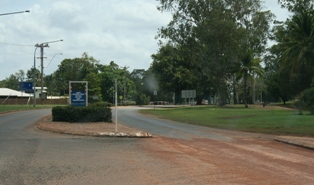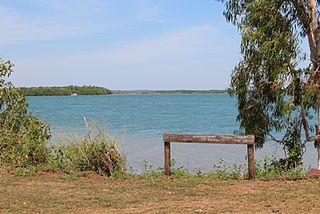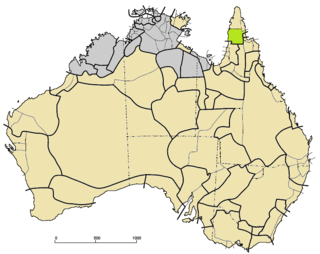
Cape York Peninsula is a peninsula located in Far North Queensland, Australia. It is the largest wilderness in northern Australia. The land is mostly flat and about half of the area is used for grazing cattle. The relatively undisturbed eucalyptus-wooded savannahs, tropical rainforests and other types of habitat are now recognised and preserved for their global environmental significance. Although much of the peninsula remains pristine, with a diverse repertoire of endemic flora and fauna, some of its wildlife may be threatened by industry and overgrazing as well as introduced species and weeds.

Weipa is a coastal mining town in the local government area of Weipa Town in Queensland. It is one of the largest towns on the Cape York Peninsula. It exists because of the enormous bauxite deposits along the coast. The Port of Weipa is mainly involved in exports of bauxite. There are also shipments of live cattle from the port.

The Shire of Aurukun is a local government area in Far North Queensland, Australia. The shire covers part of western Cape York Peninsula, the most northerly section of the Australian mainland.

Aurukun is a town and coastal locality in the Shire of Aurukun and the Shire of Cook in Far North Queensland, Australia. It is an Indigenous community. In the 2016 census, the locality of Aurukun had a population of 1,269 people.

The North Cape York Paman languages are a subdivision of the Paman languages consisting of forty languages, all spoken on the Cape York Peninsula of Queensland, Australia. The languages are grouped largely according to R. M. W. Dixon. The only extant branches of this family are Umpila and the Wik languages. The now-extinct Northern Paman branch was unique among Pama-Nyungan languages in containing fricatives.

The Wik languages are a subdivision of the Paman languages consisting of sixteen languages, all spoken on the Cape York Peninsula of Queensland, Australia. This grouping was first proposed by R. M. W. Dixon.
Wik-Ngatharr, or Wik-Alken (Wik-Elken), is a Paman language spoken on the Cape York Peninsula of Queensland, Australia, by the Wik-Ngatharr people. It is a co-dialect with Wik-Ngathan, and more distantly related to the other Wik languages. In 1981 there were 86 speakers.
Wik-Mungkan, or Wik-Mungknh, is a Paman language spoken on the northern part of Cape York Peninsula of Queensland, Australia, by around 1,000 Wik-Mungkan people, and related peoples including the Wikalkan, Wik-Ngathana, Wikngenchera language groups. Wik Mungkan is healthier than most other languages on the peninsula, and is developing and absorbing other Aboriginal languages very quickly.
Wik-Ngathan, or Wik-Iinjtjenj (Wik-Iinychanya), is a Paman language spoken on the Cape York Peninsula of Queensland, Australia, by the Wik-Ngathan people. It is closely related to the other Wik-Ngathan language, Wik-Ngatharr and more distantly to the other Wik languages. In 1981 there were 130 speakers.

The Paman languages are an Australian language family spoken on Cape York Peninsula, Queensland. First noted by Kenneth Hale, Paman is noteworthy for the profound phonological changes which have affected some of its descendants.
The Thaayorre, or Kuuk Thaayore, are an Australian people living on the southwestern part of the Cape York Peninsula, Queensland in Australia, primarily in the settlement Pormpuraaw, having its foundation in the Edward River Mission.
Wik-Me'nh is a Paman language of the Cape York Peninsula of Queensland, Australia
Wik Paach (Wikapatja), also known as Abodja, is an extinct Australian language of Queensland. It remains unclassified. The form of the name comes from one of the Wik languages, where wik means "language", but Paach is not itself a member of that family.
Edward River is a rural locality in the Shire of Cook, Queensland, Australia. In the 2016 census Edward River had a population of 0 people.
The Holroyd River is a river located on the Cape York Peninsula in Far North Queensland, Australia.
The Kendall River is a river in Far North Queensland, Australia.
The Wik-Mungkan people are an Aboriginal Australian group of peoples who traditionally ranged over an extensive area of the western Cape York Peninsula in northern Queensland and speak the Wik Mungkan language. They were the largest branch of the Wik people.
The Ayapathu people, otherwise known as the Ayabadhu or Aiyaboto, were an Indigenous Australian group, living on the western side of the Cape York Peninsula in northern Queensland.
The Kugu Nganhcara, also Wikngenchera, Wik-Ngandjara (Ngandjara) are an Australian group of peoples living in the middle western part of the Cape York Peninsula, Queensland in Australia. Today they are primarily concentrated at Aurukan and the Edward river settlement.
The Wik Epa, also spelt Wikepa, are an Aboriginal Australian people, one of the Wik peoples of the Cape York Peninsula of northern Queensland.
Smith, Ian and Johnson, Steve, 1986. Sociolinguistic patterns in an unstratified society: The patrilects of Kugu Nganhcara. Journal of the Atlantic Provinces Linguistic Association 8:29–43.







